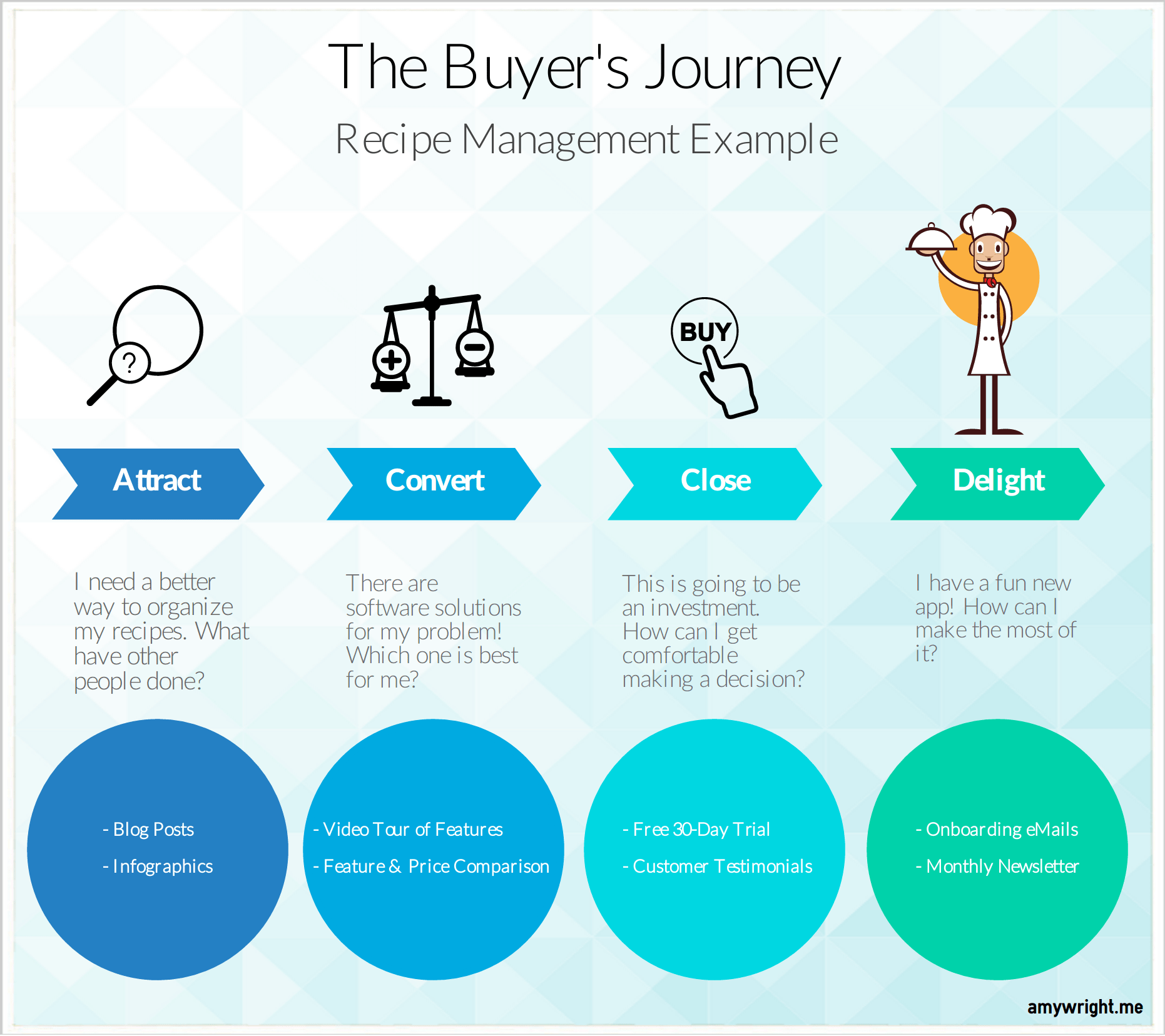
It’s easy to understand why content marketing has become so popular.
I mean, who doesn’t love the idea of attracting a target audience organically (ahem, for free) by sharing unique, helpful, or thought-provoking nuggets of wisdom? All you need to do is spend a couple of hours whipping up a killer blog post. Then publish it and relax while you watch the traffic and leads roll in. Right?
Unfortunately, it’s not quite that simple.
Content marketing is about more than blogging. Content marketing is about scrutinizing your entire online presence through the eyes of your customers because every single touchpoint will impact your success. That includes every page of your website, every resource or blog article, and every post on social media.
Of course, when you think about it that way, it sounds exhausting! But it doesn’t have to be.
That is why content strategists love the buyer’s journey. The buyer’s journey helps you visualize the customers’ research process and what they need from you at each step. It makes it easier to audit and spot gaps in your content, organize and prioritize your editorial calendar, conduct keyword research, and design campaigns.
Let’s explore how this works.
What Is the Buyer’s Journey?
The buyer’s journey is a framework that follows the customer experience as they identify a need or problem, research possible solutions, make their decision, and engage with your brand. Although the precise terms you use may differ, the buyer’s journey typically looks something like this:

You may notice that this framework is closely related to the traditional marketing funnel. But, instead of focusing on what your company needs to do to make a sale, it looks at what the customer needs throughout their experience.
The buyer’s journey is sometimes portrayed as just the first three steps. But while the marketer’s job technically ends with the purchase, the customer’s experience does not. So I find it much more useful to take a holistic view of this journey. That will help you look for ways to keep your message consistent, improve the entire customer experience, and keep them engaged with your brand.
The Buyer’s Journey in Action
To see how the buyer’s journey can impact your content strategy, let’s apply it to a small business.
Imagine you are a software engineer who also loves cooking. As a passion project, you decide to develop and market a software application for cooks. The app lets you capture all your recipes in one place and use them to create meal plans and grocery lists.

You build a website and a Facebook page. You have heard a blog can help attract customers, so you start blogging about all the fun things you can do with your software.
You score a handful of paying customers. But it isn’t nearly the success you were hoping for, and you are starting to run out of blog post ideas. So you decide to enlist the help of your friend, Laura, who is a professional content marketer.
After reviewing what you have accomplished so far, Laura suggests you shift the focus of your messaging from the product to your customers.
Laura explains that it will be easier to attract the attention of potential customers if you blog about the problems they face and offer solutions. She says the goal is to earn their trust and become a familiar resource so they will be more receptive to what you offer.
That sounds reasonable, but you are still not sure how to put it into action. So Laura presents you with the following:

This example buyer’s journey focuses on someone who is looking for a recipe management solution. At the bottom is a suggestion for the types of content that would be useful at each stage of their journey.
The content in the attract stage will address problems related to recipe management and offer solutions. These materials should be designed to attract website traffic and demonstrate your expertise. They will then direct the reader toward the other materials, which will be optimized for conversion.
Each piece of content serves a purpose, but it is the combination that’s powerful. When you look at your content this way, you can see how each piece moves the customer through their research process and closer to making a purchase. You can also see how the absence of content at any stage of this journey could result in a lost sale.
This is exciting! You want to start creating right away! But Laura has more advice.
Laura points out that it will be rare for a customer to follow this precise path. She created this illustration to provide you with perspective and help with your planning. But you have more work ahead of you.
You will need to develop buyer personas, conduct keyword research, and brainstorm a list of blog post topics. You should also consider the suggested content for each stage and decide what you can reasonably tackle, considering your resource constraints. Once you are clear on everything you plan to develop, you can prioritize and plot it on an editorial calendar. That will help you to be realistic about the time involved and will keep you on track.
Naturally, this is just a starting point. Since your app also helps people with meal and grocery planning, there are plenty of other topics you could address. For now, however, this is a good place to start.
Got it.
You feel great. You have a lot of work ahead of you, but at least you know what to do and why you need to do it. And you’re already considering how you could boost the reach of this content by devoting some funds to advertising.
The Value of Mapping Your Buyer’s Journey
There isn’t just one way of planning content. But creating content without a clear, documented vision of why you are creating it and what you expect it to do for you is a recipe (yes, pun intended) for disaster.
Content creation is an investment, and it takes time to produce results. Organizations that take a shotgun approach are often the ones that get frustrated and decide content marketing doesn’t work. The best way to avoid this is by creating a documented strategy that aligns with your business goals. Yet, that isn’t easy to do.
Content should focus on the needs and questions of your target market. Mapping your content to the buyer’s journey is a good way to ensure you are meeting those needs. It will help you clarify the goals of each piece of content and spot gaps so you can develop a plan to address them.


